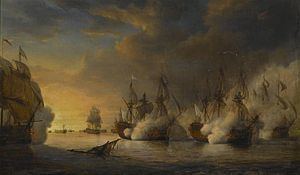Date 25 October 1747 Location Cape Finisterre, Spain | Result Decisive British victory | |
 | ||
14 ships of the line 8 ships of the line
252 merchantmen and others 154 killed
558 wounded 6 ships of the line captured
800 killed and wounded,
4,000 captured
7 ships of the convoy captured Combatants Kingdom of Great Britain, Early modern France Similar First Battle of Cape Finisterre, War of the Austrian Succession, Battle of Pfaffenhofen, Battle of Toulon, Battle of Saint‑Louis‑du‑Sud | ||
Second battle of cape finisterre 1747
The Second Battle of Cape Finisterre was a naval battle which took place on 25 October 1747 (14 October 1747 in the Julian calendar then in use in Britain) during the War of the Austrian Succession. A British fleet of fourteen ships of the line commanded by Rear-Admiral Sir Edward Hawke intercepted a French convoy protected by eight French ships of the line commanded by Admiral Desherbiers de l'Etenduère.
Contents
- Second battle of cape finisterre 1747
- Prelude
- Battle
- Aftermath
- Britain Edward Hawke
- France des Herbiers de lEtendure
- References
The battle took place in the eastern Atlantic, roughly halfway between Ireland and Cape Finisterre in northwest Spain. It was a decisive British victory that has been described as "the most brilliant naval action of the war". It put an end to French naval operations for the remainder of the war, thus eliminating any threat of an invasion of Britain and threatening the very existence of France's empire overseas.
Second battle of cape finisterre 1747
Prelude
North America was a secondary theatre of the War of the Austrian Succession, principally fought between France and Britain, and was a source of raw materials for both sides. Britain's Royal Navy had disrupted France's transatlantic trade in the past, notably at the First Battle of Cape Finisterre on 14 May 1747. France made a second attempt to reopen the supply routes in October of that year, assembling 252 merchantmen in the Basque Roads off La Rochelle. They would be protected by eight men-of-war from Brest.
The British got wind of this huge convoy, and dispatched a squadron of 14 smaller ships from Plymouth on 20 August (9 August Julian). Hawke was given the command at the last minute after Sir Peter Warren had fallen ill with scurvy. The French set off on 17th (6th) October, and were sighted by Hawke's fleet eight days later at 7am.
Battle
Initially Hawke thought he was up against a much larger fleet of warships, and formed a line of battle; when the French responded in kind Hawke realised that he was faced by inferior numbers that could be progressively enveloped by a "swarm" of ships. This allowed the British to make up for their inferior individual firepower by concentrating their fire on one ship at a time as Anson had done back in May, rather than rigidly sticking to a line of battle. At first the French mistook the British ships for members of the convoy; on realising their mistake the French hoped to use their warships to just divert the British for long enough that the merchants had a chance to escape into the vastness of the Atlantic.
Hawke approached from leeward while the French sailed close-hauled in a line ahead, hoping he would engage in a long-range artillery duel. Instead, Hawke made the signal for a general chase, freeing his captains from the constraints of a formal battle. The British overhauled the French line and enveloped it from rear to van, capturing six ships. The Comte de Vaudreuil in Intrépide, first in the French line, turned back to help his admiral, allowing both ships to escape. The French also lost 4000 men, which would prove as devastating as the loss of the ships themselves.
The merchants escaped under the protection of the Content 64 and Castor 26, and continued across the Atlantic. However most of them were intercepted and captured in the West Indies by Commodore George Pocock in the winter of 1747-48.
Aftermath
This disaster convinced the French government of its helplessness at sea, and it made no further efforts to fight convoys through the British blockade. This soon brought most of France's colonies close to starvation particularly in the West Indies. For example Martinique was successfully blockaded by the Royal Navy from their new base at English Harbour in Antigua thus bringing France to the negotiating table despite her victories in the Low Countries and elsewhere. King Louis decided to give back the Netherlands in return for normality in the colonies. The psychological impact of the battles of Cape Finisterre continued into the Seven Years' War (1756–1763), as King Louis would prove reluctant to send men and supplies to New France and her other colonies.
